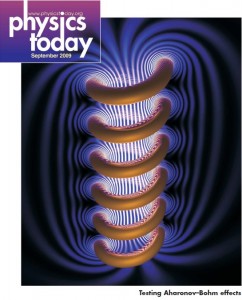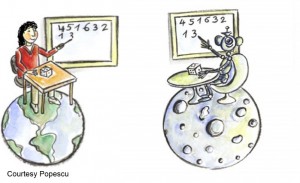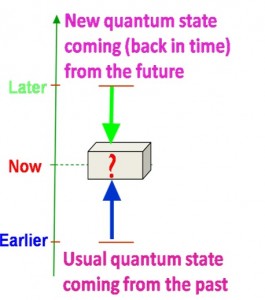Chapman University scientists introduce new cosmic connectivity
Recently physicists at Chapman University’s Institute for Quantum Studies introduced the Quantum Cheshire Cat. Now they have introduced another quantum animal: the Quantum Pigeon as reported in worldwide media including a feature article in the July 30 issue of
New Scientist
,
Nature
,
PhysicsWorld
, the
BBC
, and more.
In the 20th century, two revolutions in physics shook the world. One of them was relativity, discovered by Einstein. It revealed that spacetime is not what we experience in everyday life. For example, if you travel close to the speed of light, then you will age more slowly than somebody who stays on Earth.
The second revolution was quantum theory, the microscopic theory of particles, such as electrons, atoms, or photons. Quantum theory showed that nature is not deterministic—as Einstein put it, “God plays with dice.” After a century of careful testing, most physicists believe that the “chanciness” or “capriciousness” of the microscopic world is fundamental.
One of the most exotic aspects of nature is quantum non-locality which was first discovered more than four decades ago. It is referred to as “the most profound discovery of science.”

There are different types of non-locality which quantum mechanics showed could not exist in classical physics. In classical physics for a particle to experience a force, it must be at the same location where the force is. In quantum mechanics you can have a force in one place while the particle moves outside. Nevertheless, the particle will still feel this force. This is called the Aharonov-Bohm effect.
There is another kind of non-locality that has to do with the relation between two particles that used to be next to each other in the past and then subsequently were separated to a large distance. Even after they were separated far apart, they appeared to maintain a strange kind of connection—what Einstein called “spooky action at a distance.” However, these surprising kinds of connections had many limitations. For example, the particles had to originally be next to each other and only a relatively small number of particles in the universe could be connected with each other at a time.
While the above was remarkable enough, now it appears this was only part of the story as demonstrated in a recent paper by a team from the Institute for Quantum Studies at Chapman University co-authored by Yakir Aharonov, Fabrizio Colombo, Sandu Popescu, Irene Sabadini, Daniele Struppa, and Jeff Tollaksen. They introduced a new kind of quantum connectivity between particles which transcends these limitations. This connectivity is happening all the time on a much bigger, cosmic scale.
“With the new kind of quantum linkages which we have introduced, the particles don’t have to interact in the past. In fact, they have no idea that the other particle even existed,” said Jeff Tollaksen, Director of the Institute for Quantum Studies at Chapman University.

“This is a surprising breakthrough,” said physicist Paul Davies at Arizona State University in Tempe. “It’s remarkable that it’s still possible to discover something fundamentally new about quantum mechanics, which has been around for nearly 100 years. Here we see a richer, more complex set of long-range correlations that nobody knew existed before.”
This breakthrough could only be seen by using another breakthrough also introduced by Aharonov concerning the nature of time. Our human experience of time is that it has a certain direction: we are born and then we grow older, not the other way around. But even with this experience, we are already making assumptions about the nature of time on a microscopic scale: the past that is not here, a present that is now here and the future that will be here later.
Aharonov turned Einstein’s question around and asked, “Why does God play dice?” He found that Nature gains something very beautiful and exciting with this indeterminism: the present is not only affected by the past but it is also affected by the future. That is, the future (also known as post-selection) can come back to the present (like in the movie “Back to the Future”). So quantum mechanics does not pick out an arrow of time, it works just as well from past to future as from future to past. The quantum world links the future with the past in subtle and significant ways; and in dramatic contrast to everything previously known about time.
At first blush, you might think that we could build time machines with this new physics. If we could have such time machines, then when they take us back in time, a paradox will ensue: if one goes back in time in a time machine and kills one’s grandfather, then that individual would never be born. If that individual will never be born how can they come back and kill their grandfather? This is the paradox that happens when we say that you are allowed to come back from the future and effect the past or the present.

In contrast, Aharonov (et. al.’s) theories don’t allow for such paradoxes. It does this by using the explanation for why God plays dice: quantum mechanics has just the right kind of uncertainties so that when one does experiments in the present, there is always some possible noise in the result of this experiment, some possible mistakes due to the noise in the quantum uncertainties of the measuring device. Everybody knows that if your only tool is a hammer, then you tend to treat everything as if it were a nail. And the “hammer-type” measurements that are made in the present moment are not helpful in ascertaining the relevance of the future on the present. But a whole new world opens up when gentle measurements are made. For example, in some sense, particles everywhere are now more connected than previously thought.
“It seems to be impossible,” says Tollaksen. “But it is a direct consequence of quantum mechanics” and, he adds, “It really has immense implications.”
To backup such extraordinary claims, the Chapman University team has been introducing a series of new paradoxes which are consequences of this new kind of connectivity but which also can be verified experimentally. They have called the first the “quantum pigeonhole paradox.” The classical pigeonhole principle states: “If you put three pigeons in two pigeonholes at least two of the pigeons end up in the same hole.” This is an obvious yet fundamental principle of nature as it captures the very essence of counting. Yet the Chapman team showed that it was false in quantum mechanics: “You can put an infinite number of pigeons in two boxes, and no two pigeons will be in the same box,” says Tollaksen (see arxiv.org/abs/1407.3194).
“The new results seem fascinating,” said Leonard Susskind of Stanford University. “I would guess that the new effect is a serious step in understanding quantum correlations.”
The Chapman University team’s prediction has been receiving worldwide media attention including as a feature article in the July 30, 2014, issue of
New Scientist
.
Consistently ranked among the top universities in the West, Chapman University provides a uniquely personalized and interdisciplinary educational experience to highly qualified students. Our programs encourage innovation, creativity and collaboration, and focus on developing global citizen-leaders who are distinctively prepared to improve their community and their world. Visit
www.chapman.edu
Follow us on Facebook at:
Chapman University Facebook
On Twitter at:
@ChapmanU
On YouTube at:
Chapman University YouTube Channel
###
Categories
Recent Posts
- ANNETTE BENING, ED ASNER, AND GARY COLE JOIN CAST CRITICALLY ACCLAIMED PLAY BRINGS THE HUMAN EXPERIENCE OF WARFARE TO LIFE
- DISNEY EXECUTIVES AND OTHER ORANGE COUNTY LEADERS JOIN CHAPMAN UNIVERSITY GOVERNING BOARDS
- Chapman University’s Office of the Provost and Musco Center Presents Provost’s Arts & Lecture Series
- General H. R. McMaster visits to commemorate partnership between Chapman University and Richard Nixon Foundation
- More Category 5 Hurricanes Forecasted by Scientists
Archives
- October 2018
- September 2018
- August 2018
- May 2018
- April 2018
- March 2018
- February 2018
- January 2018
- December 2017
- November 2017
- October 2017
- September 2017
- August 2017
- July 2017
- June 2017
- May 2017
- April 2017
- March 2017
- February 2017
- January 2017
- December 2016
- November 2016
- October 2016
- September 2016
- July 2016
- June 2016
- May 2016
- April 2016
- March 2016
- February 2016
- January 2016
- December 2015
- November 2015
- October 2015
- September 2015
- August 2015
- July 2015
- June 2015
- April 2015
- March 2015
- February 2015
- January 2015
- December 2014
- November 2014
- October 2014
- September 2014
- August 2014
- July 2014
- June 2014
- May 2014
- April 2014
- March 2014
- February 2014
- January 2014
- December 2013
- November 2013
- October 2013
- September 2013
- August 2013
- July 2013
- June 2013
- May 2013
- April 2013
- March 2013
- February 2013
- January 2013
- December 2012
- November 2012
- October 2012
- September 2012
- July 2012
- June 2012
- May 2012
- April 2012
- March 2012
- February 2012
- January 2012
- December 2011
- November 2011
- October 2011
- September 2011
- August 2011

